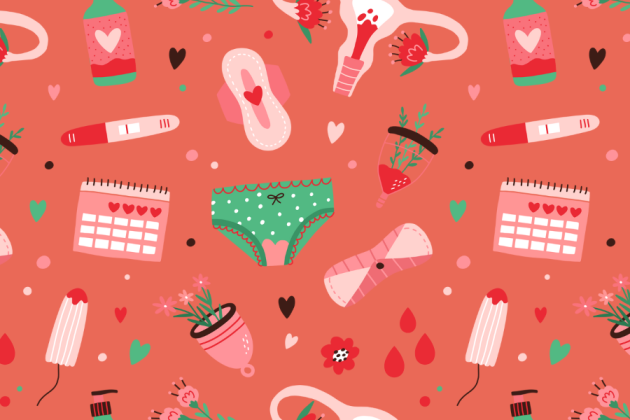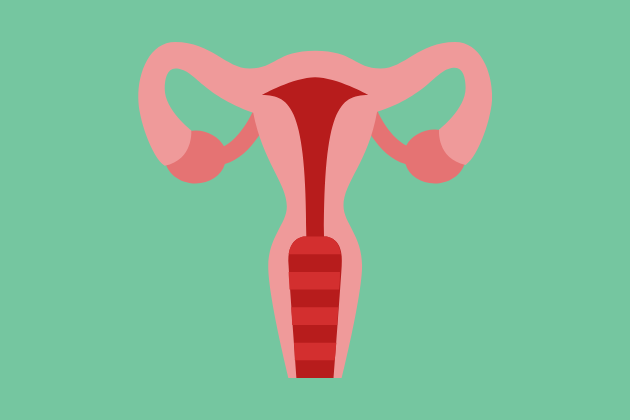
Menstruation, often called a period, is the regular discharge of blood and tissue (known as menses) from the inner lining of the uterus through the vagina*. Your first period usually begins between 12 and 15 years of age (but can start as early as 8), a point in time known as menarche.
As your body matures during puberty, your ovaries start to release the hormones estrogen and progesterone. These hormones cause the lining of the uterus to build up. The built-up lining is your body’s way to get ready for a fertilized egg to attach and start developing (a pregnancy). If there is no fertilized egg, the lining breaks down and bleeds. This process for the lining to build up, then break down, happens about once a month (it’s normal for cycles to vary from 21 to 35 days). This is what causes you to bleed from your vagina for a few days (around 2 to 5 days although it can be pretty irregular at first). The blood can range from brownish to a bright red colour, thick or thin, and sometimes comes in clots.
Everyone’s period looks a bit different including when they start happening, the amount of blood that comes out, how long they last, and what side effects they experience. How frequent and predictable periods are can vary for a few reasons. Your period may be irregular for the first couple years of getting it. Similarly, periods can become less predictable when you are approaching menopause. How long and how often you get your period can also change because of being on hormonal contraception (e.g. the pill or a hormonal IUD), drug use, eating disorders, intense physical training, and many other things that change your body’s chemistry. Getting your period can feel stressful at first and that is totally valid.
There are many options for what menstrual products to use during your period. You can use:
- Tampons (highly absorbent cotton cylinders you insert into the vagina – they come in different sizes),
- Pads (absorbent disposable pad of cotton that sticks to your underwear, or reusable pads that can be washed),
- Period underwear (extra absorbent underwear designed to soak up menstrual fluid), or
- Menstrual cups or discs (reusable, washable cup that catches your menstrual blood)
You may experience side effects like cramping, body aches, headaches, or diarrhea during your period. Taking a warm bath or sitting with a heating pad on your lower back or abdomen can help with aches, pains or cramps, and so can taking over-the-counter pain relievers (like ibuprofen, acetaminophen, naproxen, etc.).
You may also experience more pronounced mood swings around your period due to hormonal changes in your body. Conditions like endometriosis can also cause extremely painful cramps or heavier bleeding. If you experience intense symptoms that are interfering with your life, know that you are not the only one and you can get support by visiting a health care provider.
Tracking Your Cycle
Tracking your cycle can be a helpful practice for knowing what is normal for you and your body. This can include keeping note of changes in your mood, energy level, vaginal discharge, or even other health issues. It can be as simple as making a quick note on your calendar or using an app to track when you get your period.
Based on your regular patterns, you might be able to predict when you’re most likely to ovulate, and having a record of symptoms like migraines or intense cramps can be useful when seeking out medical advice
Perimenopause
Perimenopause is when you start transitioning towards menopause. It's the time when the ovaries start to make less and less estrogen. It usually starts in your forties but can start as early as your thirties. The average length of perimenopause is four years but for some people this stage may last only a few months or continue for 10 years. Perimenopause ends when you have gone 12 months without having your period.
During perimenopause, you can experience a range of symptoms like hot flashes, vaginal dryness, mood swings, fatigue, difficulty sleeping, and irregular periods. Periods that may have been regular might get longer or shorter, or more time may pass between periods.
Menopause
Menopause is when menstrual periods stop permanently and you can no longer get pregnant. After menopause, your body makes much less of the hormones estrogen and progesterone. Very low estrogen levels after menopause can affect health and cause symptoms such as hot flashes. It can also bring some lifestyle changes, including the introduction of important routine tests, to relieve symptoms and ensure good health and wellness. While the list of possible symptoms can feel disheartening, some of the physical changes caused by reduced hormone levels may be welcomed (e.g. fibroids shrinking, no more hormonal headaches, no more PMS) and for some, the emotional and social changes can feel energizing.
Every person’s menopause experience is different. Physical, mental, and emotional changes that accompany this stage of life can be frustrating and isolating. Self-care during this time can look like increased dedication to adequate sleep, exercise, and managing stress. It can also look like dietary changes, hormone replacement therapy, or anti-depressants. It can feel helpful to get support from family, friends, and health care providers to help figure out what is most helpful during this big transition.
* Not everyone uses these words for their body parts or relates to them in the same way. We have used these words as they are commonly known and encourage you to use the language that feels best for you.

